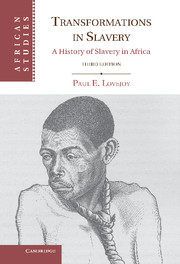Book contents
- Frontmatter
- Contents
- Maps and Tables
- Note on Currencies, Weights, and Measures
- Preface
- Preface to the Second Edition
- Preface to the Third Edition
- 1 Africa and Slavery
- 2 On the Frontiers of Islam, 1400–1600
- 3 The Export Trade in Slaves, 1600–1800
- 4 The Enslavement of Africans, 1600–1800
- 5 The Organization of Slave Marketing, 1600–1800
- 6 Relationships of Dependency, 1600–1800
- 7 The Nineteenth-Century Slave Trade
- 8 Slavery and “Legitimate Trade” on the West African Coast
- 9 Slavery in the Savanna during the Era of the Jihads
- 10 Slavery in Central, Southern, and Eastern Africa in the Nineteenth Century
- 11 The Abolitionist Impulse
- 12 Slavery in the Political Economy of Africa
- Epilogue
- Appendix Chronology of Measures against Slavery
- Notes
- Select Bibliography
- Index
- Books in this series
7 - The Nineteenth-Century Slave Trade
Published online by Cambridge University Press: 05 June 2012
- Frontmatter
- Contents
- Maps and Tables
- Note on Currencies, Weights, and Measures
- Preface
- Preface to the Second Edition
- Preface to the Third Edition
- 1 Africa and Slavery
- 2 On the Frontiers of Islam, 1400–1600
- 3 The Export Trade in Slaves, 1600–1800
- 4 The Enslavement of Africans, 1600–1800
- 5 The Organization of Slave Marketing, 1600–1800
- 6 Relationships of Dependency, 1600–1800
- 7 The Nineteenth-Century Slave Trade
- 8 Slavery and “Legitimate Trade” on the West African Coast
- 9 Slavery in the Savanna during the Era of the Jihads
- 10 Slavery in Central, Southern, and Eastern Africa in the Nineteenth Century
- 11 The Abolitionist Impulse
- 12 Slavery in the Political Economy of Africa
- Epilogue
- Appendix Chronology of Measures against Slavery
- Notes
- Select Bibliography
- Index
- Books in this series
Summary
The Dynamics of Slavery in the Nineteenth Century
By the beginning of the nineteenth century, the slave trade from Africa had assumed gigantic proportions. It was the largest human migration to date, and hence can be regarded as the first of the world’s modern migrations. The peculiar nature of this migration, based as it was on slavery, made its organization complex, for the infrastructure necessary to move such large numbers of people against their will required the mobilization of resources on several continents. After the temporary decline caused by war in Europe during the 1790s and the first decade of the nineteenth century, the trans-Atlantic slave trade from the Guinea coast resumed its previous level, and the export trade now affected East Africa considerably. Slaves became more common wherever the export trade was important. The transformation of the political economy that resulted in the more systematic enslavement of people and the organization of the domestic slave trade pushed the African societies involved toward the more intensified exploitation of slave labor. Indeed, the productive dimension of slavery became more important than ever before.
A new factor in the history of slavery in Africa emerged in the midst of this situation. This factor was the movement to abolish the slave trade. Reformers began to attack the trade in the last decades of the eighteenth century; the first United States laws were enacted in 1791 and 1794; Denmark instituted abolition in 1802; in 1807, Great Britain, the largest carrier of slaves to the Americas, made it illegal for her merchants to participate in the trade. The United States embarked on the same path in 1808, the same year that British laws actually became effective. From then on, despite many setbacks, half-hearted enforcement, and extensive smuggling, the days of slavery were numbered. The British government subsequently pressured other European and New World countries to follow its lead, a diplomatic effort that took most of the nineteenth century before the trans-Atlantic trade really came to an end. Besides its diplomatic assault, Great Britain stationed part of its navy off the African shore to enforce abolition. France, the United States, and other countries joined this military effort. This blockade, which was relatively ineffective early in the nineteenth century, had an increasingly severe impact on the trade, making it difficult for ships to buy slaves in many places. The full effects of these measures, however, were not really felt until the 1840s and later still in East Africa.
- Type
- Chapter
- Information
- Transformations in SlaveryA History of Slavery in Africa, pp. 135 - 159Publisher: Cambridge University PressPrint publication year: 2011



